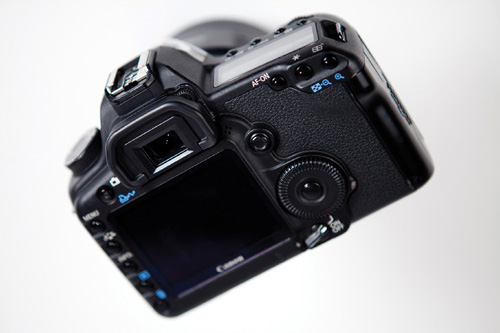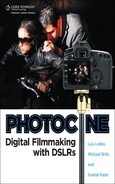By Lou Lesko and Michael Britt
In 2008, HD video capability was added to DSLR (Digital Single Lens Reflex) cameras with the introduction of the Nikon N90, which shoots 720p (1280×720) 24fps video with an APS-sized sensor (23.6mm×15.8mm). This camera quietly ushered in the convergence of stills and video, but for several reasons, including the choice of using 720p instead of 1080p video, this camera failed to capture the attention of the filmmaking community.
Canon accidentally ignited the fuse that led to this HDSLR revolution by being smart enough and quick enough to ride the coattails of Vincent Laforet’s experimental short called Reverie (see http://www.vincentlaforet.com/index_reverie.html). Canon designed the 5D Mark II for Reuters and Associated Press as a single unit that photojournalists could use to shoot stills and video footage for their respective news outlets. The camera originally launched with no manual exposure controls and only capable of capturing 30fps 1080p video. Speculation was that it was released before it was ready because of the Nikon N90 debut. The 5D Mark II was a niche product until Vincent, a photojournalist and a Canon Explorer of Light, picked up one of the first prototypes from Canon U.S.A. in New Jersey and decided to unleash his dormant filmmaker lurking within. His short video went viral and exposed the photo and video community to the capabilities of this camera and the beauty of its cinema film look.
Vincent had no financial backing for Reverie or experience making movies, just a desire to push the bounds of his creativity using the technology available to him through his connections as a New York Times photographer. Canon U.S.A. moved quickly to purchase the rights from Vincent to use the video to promote the camera, and DSLR filmmaking was launched. Excitement grew when manual exposure control and 24fps video capture were added in firmware updates.
Around this time period, Panasonic released its new Micro Four Thirds camera, the GH1. The Micro Four Thirds system was developed jointly by Olympus and Panasonic to share an image sensor size and specification, as well as a standard interchangeable lens mount. Filmmaker Liam Finn used the Panasonic GH1 when he wrote and directed the first full-length feature film shot on a still camera with video capabilities—REJOUER (pronounced ri-joo-wey). Liam worked with Illya Freidman from Hot Rod Cameras to create a PL (Positive Lock) mount adapter for the GH1 allowing PL movie lenses to be used on the small GH1 camera. You can read more about this project at http://www.finndependent.com/movie.html.
The Panasonic GH1 is in a new class of cameras labeled with the unfortunate acronym—EVIL, which stands for Electronic Viewfinder Interchangeable Lens. As the acronym states, these cameras use interchangeable lenses and generally have large sensors like HDSLRs. The lack of a mirror box mechanism, which is replaced by an electronic viewfinder, is the reason they don’t technically fall under the DSLR heading, since SLR stands for Single Lens Reflex and describes the process of seeing exactly what will be captured by the film or sensor with the use of a moving mirror optical system.
The Micro Four Thirds chip size is smaller than the Canon 5D Mark II, which is 35mm. This is still photo size, but closer in line to 35mm movie film frames. See the chart for chip size comparison. Because of the smaller but still comparatively large sensor size, Micro Four Third cameras can easily be adapted to use most still lenses as well as professional cinema lenses.
DSLRs will probably be replaced by EVIL cameras in the not-too-distant future. The analog mechanical nature of the DSLR design is a holdover from when electronic viewfinders just weren’t possible. A lot of photographers still like to look through the lens of an SLR, but with the advances in LCD screen technology, it isn’t necessary anymore. The trade-off, in addition to size, is that once the mechanical bits are removed, cameras become straight electronic devices that roughly follow Moore’s Law, becoming easier and cheaper to manufacture.
In addition to Nikon, Canon, and Panasonic, Pentax released its rugged K-7 HDSLR that shoots HD video at 30fps in an unusual resolution of 1536×1024 instead of the more common full HD standards of 1920×1080 and 1280×720. This non-standard format matches the 3:2 aspect ratio of the image sensor. Pentax took a play out of the Canon marketing handbook and produced high-quality shorts to help virally advertise the camera’s video capability. One of the resulting videos is called Uncle Jack and it’s one of the most entertaining shorts I have ever seen. You can see Uncle Jack as well as the making-of on the Pentax YouTube channel at http://www.youtube.com/user/pentaxian1.
Sony came late to the game with their prosumer DSLR camera line and had the misfortune of launching still cameras with no video capability right as the DSLR video revolution was getting started. Their Alpha line with Zeiss lenses are good cameras, but the market didn’t really need another line of straight DSLRs and conjecture was that Sony might cancel the Alpha program. Instead, Sony added video to their refreshed lineup in August of 2010, incorporating some innovative technology along the way. The Sony cameras shoot 1920×1080 video and capture stereo sound (versus mono sound on most other DSLRs). Some models have a flip-out LCD screen.
The Sony α55 and α33 use a new fixed Translucent Mirror Technology that instead of getting rid of the mirror box, converted it into a two-way mirror that doesn’t have to move up and out of the way to expose the sensor. Pellicle mirror cameras have been produced before, aimed mostly at sports photographers who don’t want to miss a shot while the viewfinder is blacked out, but this is the first time they have been used in a camera with video capability. Sony is playing catch-up, but they did get a boost when Zeiss announced that the interchangeable mount on the CP.2 cinema lenses would be available in a Sony Alpha version. Sony is really good at making and selling consumer electronics, so remember what I said about cameras becoming electronic devices once the mirror is removed and keep an eye on Sony in this market. The good news at this point is that all DSLR cameras now shoot video.

When the Canon 5D Mark II was announced in 2008, the high-definition video capabilities barely impacted professional photographers. Indeed, the hi-def video feature was an afterthought to the camera. No one really gave the feature a second glance until videos that looked like movies that were made by photographers started popping up on the Internet. About this time, I wrote an article for Digital Photo Pro about how photographers were going to have to learn how to become short-form filmmakers as the convergence of photo and video was upon us. I was much maligned for my opinion. I got hate mail, and in the words of one now ex fan, “my years of predicting trends in the photo industry were behind me.”
Three months later the photo industry exploded with hi-def videos made with the Canon 5D Mark II. My coauthor, Michael Britt, saw the same trend I did, and with his business partner, Tom Stratton, they launched the very first conference dedicated to the convergence of photography and video in history, called the Collision Conference. Because of my article, I was asked to speak at the conference, which is where Michael Britt and I met.
Videos started to pop up everywhere. Some made by photographers and many made by commercial and movie DPs. The form factor was changing everything, and it looked like the invisible barrier between the photography industry and Hollywood was starting to disintegrate. Now a photographer could make a movie and maybe have a runaway hit—a domain once exclusive to film students. As you’ll see as you read this book, photographers are surprisingly adept at shooting motion. In some regards, their photographic training makes them inherently better than some people that set out to be movie makers. Finally an opportunity to escape the shadow of Hollywood was presenting itself to photographers, except the photo industry wasn’t running for the sunlight.
When the first videos made by photographers with the Cannon 5D hit the Internet, the industry got all aflutter. Collective oohs and ahhs were everywhere. The vignettes were beautifully shot, but there wasn’t a narrative thread. Publicly, I wrote about my lack of enthusiasm for what I was seeing, because I knew on the other side, the movie side, that these vignettes were amateurish because they had no story. This position once again found me in controversial territory, seemingly at odds with the photo industry. But my intent was the opposite. If photographers were going to move into motion, they needed to do more than stitch together a bunch of gorgeous video snippets. They needed to convey a story or risk losing their audience and the opportunity to break into a new genre.

Canon 5D
What these amazing pioneering photographers had done was show people how to step into a new world. Well-known Hollywood DPs were soaking up the information as the photographers solved more and more problems that arose with the form factor. And then those very same DPs put their experiments with the Canon 5D online, and the world got stunning imagery and story. I assumed that the natural competitive sprit of photographers would have them incorporating narrative almost immediately. I was wrong.
I hit the road and made a presentation in Seattle about three-act story structure. A week later National Geographic had me out to Washington D.C. to make the same presentation to their photographers. What’s happening in the photo industry today is an obsession with the technology and a complete ignorance of story.
Unfortunately, the photo industry doesn’t have a lot of time to pull on both technological and story-telling hats. Conveying a story in motion is different than in stills. It’s more complicated and needs to take the viewer on a journey. With the advent of video, advertising agencies have greater expectations for photographers. This includes the ability to write a treatment. Photographers have to think of themselves in a whole new way. Photographers now need to be filmmakers that can shoot stills really well.


